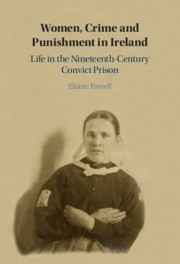Book contents
- Women, Crime and Punishment in Ireland
- Women, Crime and Punishment in Ireland
- Copyright page
- Dedication
- Contents
- Figures, Maps and Tables
- Acknowledgements
- Abbreviations
- Introduction: ‘Another generation of jail-birds’
- Case Study 1 ‘The terrible temptation’
- Case Study 2 ‘A gang of coiners’
- Case Study 3 ‘The workhouse girls’
- 3 ‘Even in prison, they have those extreme friendships, antipathies, and jealousies’
- Case Study 4 ‘A person of very superior attainments’
- Case Study 5 ‘A most remote part of the country’
- Bibliography
- Index
3 - ‘Even in prison, they have those extreme friendships, antipathies, and jealousies’
Convict Relationships
from Case Study 3 - ‘The workhouse girls’
Published online by Cambridge University Press: 21 September 2020
- Women, Crime and Punishment in Ireland
- Women, Crime and Punishment in Ireland
- Copyright page
- Dedication
- Contents
- Figures, Maps and Tables
- Acknowledgements
- Abbreviations
- Introduction: ‘Another generation of jail-birds’
- Case Study 1 ‘The terrible temptation’
- Case Study 2 ‘A gang of coiners’
- Case Study 3 ‘The workhouse girls’
- 3 ‘Even in prison, they have those extreme friendships, antipathies, and jealousies’
- Case Study 4 ‘A person of very superior attainments’
- Case Study 5 ‘A most remote part of the country’
- Bibliography
- Index
Summary
Through shared spaces and experiences, alliances, friendships and animosities developed between inmates from diverse backgrounds, as well as between prisoners and the staff charged with their care and control, Chapter 3 focuses on relationships that developed or were sustained in the predominantly female environment of the women’s convict prisons. Facilitated by the tendency for meticulous record-keeping in the vast penal system, this chapter relies heavily on records relating to perceived misbehaviour to demonstrate how alliances and rivalries were formed, expressed and navigated behind bars. This also includes an analysis of relationships that developed between staff and inmates across assumed boundaries of power. The out-of-turn conversations, laughter, name-calling and arguments indicate the interconnectedness of women’s lives behind bars. As this chapter shows, alliances and rivalries emerged despite the prison regime, but also perhaps because of it. It argues that the development of friendships and animosities was inevitable within the prison confines. This chapter also demonstrates that friendships forged or cemented in the institution were not necessarily forgotten on release.
Keywords
- Type
- Chapter
- Information
- Women, Crime and Punishment in IrelandLife in the Nineteenth-Century Convict Prison, pp. 135 - 174Publisher: Cambridge University PressPrint publication year: 2020

